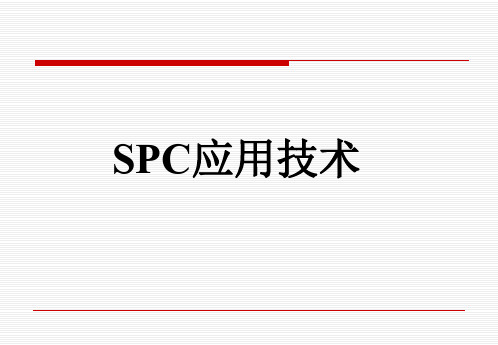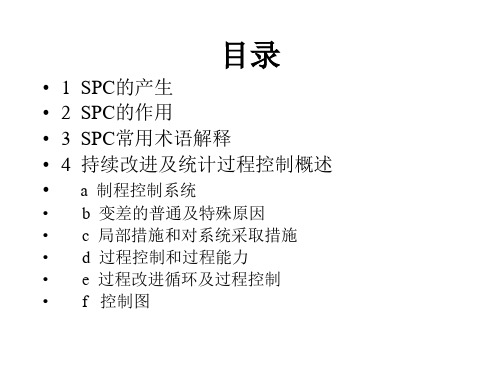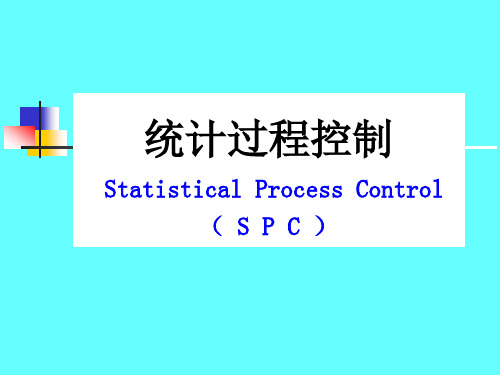SPC过程能力培训教材(English)
spc完整培训教材

• 可以分解Data, 且测定的数据的大小有意义 • 客观性 Data : 时间, 重量, 长度等测定计测仪可以测定的Data • 主观性 Data :满足度, 充实度等 Data的测定基准按始点发生变更
离散型 Data(计数型)
• 不可能分解Data, 所测定的数据Count时. • 客观性 Data : 缺点数, 承认件数, 误差件数, 位置等判断的情况明确的内容 • 主管性 Data : 包含Yes/No, Good/Bad 等人的主观性内容的内容
工程 Parameter &
Component Parameter
Sales & SVC
SPC
测定System分析 工程能力诊断 工程能力管理
Understanding Statistics (QC, SQC)
改善活动
D
M
A
I
R&D(DfSS) Manufacturing
6 Sigma
C TQ
PPT文档演模板
※ 实际情况下离散型和连续型分类比较困难时 例 1) 主/客观式混合的数学能力分数 → 离散型但是可以看作连续型 例 2) 使用尺度法的论文结果 → 连续型处理, 还是离散型处理,按照事件, 分析的目的考虑置信度慎重判断
PPT文档演模板
spc完整培训教材
2. SPC Introduction
PPT文档演模板
* AQL(Acceptable Quality Level) : 合格品质水准 SPC(Statistical Process Control) : 统计性工程管理
PPT文档演模板
spc完整培训教材
Sampling
适用Sampling检查主要原因是经济性原因. 由于有这种经济性原因,取Sample时,Sample能够反映总体的特性。
SPC培训教材

4.異常原因之變不但可以找出其原 因,並且除去這些原因之處置,在 經濟觀點上講常是正確者
12
:
• 请列出目前制程中人,机,料,法,环境 中普通原因及特殊原因有哪些?
13
局部性的對策及系統中的對策
.特殊原因之对策(局部面) 通常会牵涉到消除产生变异的特殊原因 可以由制程人员直接加以改善 大约能够解决之制程上之问题 .共同原因之对策(系统面) 通常必须改善造成变异的共同问题 经常需要管理阶层的努力与对策 大约的问题是属于此类系统
: 是製程散差
等级 值
≦
≦ < ≦ < ≦ < <
48
精度指標
> 代表製程精良,製程散差窄於規格公差;
< 代表製程駑劣,製程散差闊於規格公差. 練習 : 某马达之 定義為 ( 算其值. ) ,而製程做出來之中心值為 ,標準差為 .請計
T 800 C 1 . 67 P 6 6 * 80
4
品管發展歷程
推動品質 活動
約每年就出現一種關鍵品質管理方法
、 (頭腦風暴) 、、 、、、 、、、、
5
• 過去,製造商經常通過生產來製造產品,通 過品質控制來檢查最終產品并剔除不符合規 範的產品.在管理部門則經常靠檢查或重新檢 查工作來找出錯誤,在這兩種情況下都是使 用檢測的方法,這種方法是浪費的,因為它 允許將時間和材料投入到生產不一定有用的 產品或服務中. • 一種在第一步就可以避免生產無用的輸出, 從而避免浪費的更有效的方法是——預防.
理想型:制品良好,能力足够.制程能力在规格界限 内,且平均值与规格中心一致,平均值加减倍标准 差为规格界限,制程稍有变大或变小都不会超过 规格值是一种最理想的直方图.
8 7 6 5 4 3 2 1 0
2024版SPC培训教材全课件

假设检验的基本概念
明确假设检验的定义、原假设与备择假设的设立原则及两类错误 的含义。
参数假设检验
掌握正态总体均值、方差的假设检验方法及步骤,理解t检验和F 检验的原理及应用场景。
非参数假设检验
了解非参数假设检验的适用条件及常用方法,如秩和检验、符号 检验等。
16
方差分析、回归分析应用举例
方差分析
掌握方差分析的基本原理、计算步骤及结果解释,理解其在多因素实验设计中的应用。
化。
大数据在SPC中的应用
大数据技术的不断发展将为SPC提供更丰富的数据来源和分析手段,有助于提高SPC的 应用效果。
2024/1/30
SPC在服务业的拓展
随着服务业的不断发展,SPC的应用领域将逐渐拓展到服务业领域,为服务业的质量管 理提供新的思路和方法。
36
下一讲预告及预备知识
2024/1/30
01
02
03
04
明确数据收集目标
根据业务需求,明确所需数据 的类型、范围和质量要求。
2024/1/30
制定数据收集计划
设计合理的数据收集流程,包 括数据源选择、采集频率、存
储方式等。
执行数据收集
运用合适的数据收集工具和技 术,按照计划进行数据采集。
数据质量监控
建立数据质量评估机制,确保 数据的准确性、完整性和一致
下一讲内容
下一讲将介绍SPC在企业中的实际应 用案例,包括不同行业和不同场景下 的SPC应用实践。
预备知识
为了更好地理解下一讲内容,建议学 员提前了解相关行业的生产流程和质 量管理要求,以及SPC在实际应用中 的挑战和解决方案。
37
THANKS
感谢观看
2024/1/30
SPC基本认识培训教材英文

SPC Basic Training ManualIntroductionWelcome to the SPC (Statistical Process Control) Basic Training Manual. This manual is designed to provide you with a fundamental understanding of SPC and how it can be applied to improve process and product quality.Chapter 1: What is SPC?SPC is a methodology for controlling and improving the quality of processes and products. It involves the collection and analysis of data to identify and reduce variation in a process. By understanding and controlling variation, organizations can increase efficiency, reduce defects, and ultimately improve customer satisfaction.Chapter 2: Key SPC ConceptsIn this chapter, we will introduce you to the key concepts of SPC. These concepts include: - Variation: Understanding the different types of variation in a process. - Control charts: Learning how to create and interpret control charts to monitor process performance. - Process capability: Assessing the capability of a process to meet customer requirements. - Sampling: Understanding the importance of sampling techniques in data collection.Chapter 3: Tools and TechniquesIn this chapter, we will explore the various tools and techniques used in SPC. These include: - Pareto analysis: Identifying and prioritizing the most significant contributors to process variation. - Cause and effect diagrams: Investigating and understanding the root causes of process problems. - Histograms and scatter plots: Analyzingdata distributions and relationships. - Six Sigma: Applying the principles and methods of Six Sigma to improve process performance.Chapter 4: Implementing SPCIn this chapter, we will discuss the steps involved in implementing SPC in an organization. These steps include: 1. Define the process: Clearly define the process to be monitored and improved. 2. Collect data: Identify the appropriate data points and collect data over a period of time. 3. Analyze the data: Use statistical analysis techniques to identify patterns and trends in the data. 4. Implement control charts: Create control charts to monitor the process and identify out-of-control conditions. 5. Take corrective actions: When an out-of-control condition is detected, take appropriate corrective actions to bring the process back into control. 6. Continuously improve: Use the information gathered from SPC to make continuous improvements to the process.Chapter 5: SPC Case StudiesIn this final chapter, we will present real-life case studies that demonstrate the successful implementation of SPC in various industries. These case studies will highlight the benefits and the practical applications of SPC.ConclusionIn conclusion, SPC is a powerful methodology for improving process and product quality. By implementing SPC techniques, organizations can reduce defects, increase efficiency, and enhance customer satisfaction. This training manual serves as a foundation for your understanding of SPC and its applications. We encourage you to apply the knowledge gained from this manual to your own processes and make continuous improvements. Good luck on your SPC journey!。
SPC培训教材---完整版

1.简介:是SPC计量值部份最重要、最常用的管制图之一。可以使我们很好地了解制程
品质的进展状态(发展趋势)。分为:
1)解析管制图:根据实际量测出来的数据,经过计算出管制图上下限之后画出。
用途:主要用来对产品初期品质进行测定和监控,以了解在现有环境中品质的制程能力。
2)制程管制图:根据之前的历史数据,也可以根据经验或相似的各项标准,并以此为依据作为今
a 计算出标准差:
b.计算管制上、下限
Xб =
XUCL=XCL+3Xб
XLCL=XCL-3Xб
Rб =
RUCL=RCL+3Rб
RLCL=RCL-3Rб
第二种:查表法:
XUCL=
XLCL=
RUCL=
RLCL=
<案例1>
<案例1>
经过计算出每组数据的平均值和全距列表如下(注意四舍五入)
序号
检验时间
NO1
3.图形分析:
8)连续几点中有几点在1倍标准差以内 一般为连5点中有3点在1倍标准差以内,但有时候也可根据产品特
性可能有周期性而设更多点。 此种状况反应品质朝较好方向发展,所以只要注意监控,并把相
关重要参数记录下来,以利于做标准化。 9)连续几点在中心线两侧,但未在1倍标准差之内
一般为连续5点在中心线两侧,但未在1倍标准差之内,但有时候 也可根据产品特性可能有周性而设更多点。
3.SPC的基本概念:
12).管制上限(控制上限):
UCL
13).管制中心线(控制中心线): CL
14).管制下线(控制下限): LCL
15).规格上限: USL
16).规格中心线: SL
17).规格下限: LSL
SPC培训教材ppt68页15476

目标值线 预测
时间
目标值线 预测
时间
局部措施和对系统采取措施
• 局部措施
• 通常用来消除变差的特殊原因 • 通常由与过程直接相关的人员实施 • 通常可纠正大约15%的过程问题
• 对系统采取措施
• 通常用来消除变差的普通原因 • 几乎总是要求管理措施,以便纠正 • 大约可纠正85%的过程问题
过程控制
过程变差的一部分。
过程能力
是指按标准偏差为单位来描述的过程均值和规格界限
(Process Capability) 的距离,用Z来表示。
移动极差
两个或多个连续样本值中最大值和最小值之差。
(Moving Range)
制程控制系统 有反馈的过程控制系统模型
过程的呼声
人 设备
统计方法
材料 方法 环境
我们工作 的方式/资 源的融合
产品或 服务
输入
过程/系统
输出
顾客
识别不断变化的 需求量和期望
顾客的呼声
变差的普通原因和特殊原因
普通原因:是指过程在受控的状态下,出现的具有稳定的且可重 复的分布过程的变差的原因。普通原因表现为一个稳 系统的偶然原因。只有过程变差的普通原因存在且不 改变时,过程的输出才可以预测。
特殊原因:(通常也叫可查明原因)是指造成不是始终作用于过 程的变差的原因,即当它们出现时将造成(整个) 过程的分布改变。只用特殊原因被查出且采取措 施,否则它们将继续不可预测的影响过程的输出。
• 1924年,美国的休哈特博士提出将3Sigma原理运用 于生产过程当中,并发表了著名的“控制图法”,对 过程变量进行控制,为统计质量管理奠定了理论和方 法基础。
SPC的作用
• 1、确保制程持续稳定、可预测。 • 2、提高产品质量、生产能力、降低成本。 • 3、为制程分析提供依据。 • 4、区分变差的特殊原因和普通原因,作为采取局部措
2024版spc培训教材完整版

企业内部SPC培训和文化建设
• 实际操作培训:通过模拟实验、案例分析等方式,让员工亲自体验SPC技术的实际应用和操作过程。
企业内部SPC培训和文化建设
内部培训
由企业内部的专业人员或外部专家进行授课和培训,确 保培训内容的针对性和实用性。
在线学习
利用在线学习平台或企业内部网络学习资源,提供多样 化的学习方式和内容。
控制图制定
根据分析结果制定控制图,设 定控制限,并对生产过程进行 实时监控。
持续改进
根据控制图的分析结果,对生 产过程进行持续改进,提高过 程能力和产品质量。
SPC实施步骤和关键成功因素
要点一
领导层的支持
要点二
专业的实施团队
领导层对SPC实施给予足够的重视和支持,提供必要的资源 和支持。
组建具备统计技术和质量管理知识的专业团队,负责SPC的 实施和推广。
02
原则
SPC的实施遵循以下原则
03
以数据为基础
SPC通过对生产过程中产 生的数据进行收集、整理 和分析,找出影响产品质 量的关键因素。
04
05
预防为主
SPC强调在生产过程中进 行预防控制,通过监控生 产过程的变化趋势,及时 发现潜在问题并采取措施 加以解决。
持续改进
SPC鼓励企业不断寻求改 进机会,通过持续优化生 产过程和提升产品质量, 提高企业的竞争力和市场 地位。
02
测量系统分析与评价
测量系统组成及分类
测量系统组成
包括测量仪器、测量标准、测量方 法、测量人员、测量环境等要素。
测量系统分类
根据测量对象的不同,可分为长度 测量系统、角度测量系统、温度测 量系统、压力测量系统等。
测量误差来源及影响因素
统计过程控制SPC培训教材

7.4 链:控制图上—系列连续上升或下降,或在中心线之上或之下的 点。它是分析是否存在造成变差的特殊原因的依据。 7.5 链图:一种代表过程特性的简单图形,上面描有一些从过程中收 集到的统计数据(通常是单值)和一条中心线(通常是测量值的中 位数),可用来进行链分析。
三、术语
2016/11/6
1、计数型数据:可以用来记录和分析的定性数据,例如:要求的标签出 现,所有要求的紧固件安装,经费报告中不出现错误等特性量即为计 数型数据的例子。其他的例子如一些本来就可测量(即可以作为计量型 数据处理)只是其结果用简单的“是/否”的形式来记录,例如:用通 过/不通过量规来检验一根轴的直径的可接受性,或一张图样上任何 设计更改的出现。计数型数据通常以不合格品或不合格的形式收集, 它们通过p、np、c和u控制图来分析。 2、计量型数据:指定量的数据,可用测量值来分析。例如:用毫米表示 的轴承轴颈直径、用牛顿表示关门的力、用百分数表示电解液的浓 度、用牛顿²米表示紧固件的力矩、X-R图、X-S、中位数、单值和移 动极差控制图等都用于计量型数据。 3、均值:数值的总和被其个数(样本容量)除,在被平均的值的符号上加 一横线表示。例如:在一个子组内的X值的平均值记为X,X (X两横) 为子组平均值的平均值,X (X上加一波浪线)为子组中位数的平均值。 R为子组极差的平均值。 4、极差(亦称全距):一个子组、样本或总体中最大值与最小值之差 ( Max - Min )。
过程能力的分析/评估使其有量化数据/资料。以供作 为产品设计/开发和制造过程设计/开发及其改进、选 择材料、操作人员或作业方法的依据和参考,持续改 进产品质量和服务的价值,达到顾客满意。
4、SPC 实施的范围:
新产品和常规产品(包括老产品和旧产品)中, 顾客要求和公司确定的产品和过程特殊特性。
- 1、下载文档前请自行甄别文档内容的完整性,平台不提供额外的编辑、内容补充、找答案等附加服务。
- 2、"仅部分预览"的文档,不可在线预览部分如存在完整性等问题,可反馈申请退款(可完整预览的文档不适用该条件!)。
- 3、如文档侵犯您的权益,请联系客服反馈,我们会尽快为您处理(人工客服工作时间:9:00-18:30)。
Process Capability (Cp / Cpk / Pp / Ppk)Global Training MaterialCreator Function Approver Document ID Version / Status Location : Global Mechanics Process Manager : Mechanics : Jukka Mehtonen / Global Process Team : DMT00018-EN : V.2.0 / Approved : Notes : \\…\ NMP \ DOCMANR4 \ PCP \ PC Process Library DocManChange History : Issue Date1.0 2.0 21st Dec’01 17th Jun’05Handled ByCommentsJim Christy & Søren Lundsfryd Approved for Global Use Yrjo Saastamoinen Approved for Global UseNOTE – All comments and improvements should be addressed to the creator of this document.1 © NOKIA 2005 T0001802.PPT/ 17-Jun-2005 / Yrjo SaastamoinenCompany ConfidentialContentsSection 1 2 3 4 5 6 7 Heading / Description Page Variation, Tolerances and Dimensional Control 4 Population, Sample and Normal Distribution 15 Cp and Cpk Concept 28 Confidence Interval 37 Process Capability Analysis 47 Mini Cpk Cpk Data Collection Spreadsheet DMM00024 60532© NOKIA 2005 T0001802.PPT/ 17-Jun-2005 / Yrjo SaastamoinenCompany ConfidentialTool Verification ProcessMeasurement System Analysis• Calibration • Variable Gauge R&R •DMY00019, DMT00017, DMM00210Tool Approval – at Tool Maker / Supplier• FAI (DMY00019, DMT00014, DMM00061) • Precontrol: Set-up Rules5 Min Variation Short TermMachine Approval – process capability• 3-10hr Run • Process Capability: Cpk, Ppk •DMY00019, DMT00018, DMM0002410 Hr Variation Long TermProcess Performance• Ongoing production • Process Stability • Process Capability: Cpk, Ppk3 © NOKIA 2005 T0001802.PPT/ 17-Jun-2005 / Yrjo Saastamoinen6 Mo Variation PerformanceCompany ConfidentialProcess Capability - Evaluating Manufacturing Variation4© NOKIA 2005 T0001802.PPT/ 17-Jun-2005 / Yrjo SaastamoinenCompany ConfidentialSection 1 Variation, Tolerances and Dimensional Control5© NOKIA 2005 T0001802.PPT/ 17-Jun-2005 / Yrjo SaastamoinenCompany ConfidentialTwo Types of Product CharacteristicsVariable: A characteristic measured in physical units, e.g. millimetres, volts, amps, decibel and seconds. ly s on le ariab v with deal e i ng w in s tra i In t h Attribute: A characteristic that by comparison to some standard is judged “good” or “bad”, e.g. free from scratches (visual quality).ONOFF6© NOKIA 2005 T0001802.PPT/ 17-Jun-2005 / Yrjo SaastamoinenCompany ConfidentialThe Sources of Process/System VariationEquipment MethodsEnvironment ProcessCustomer SatisfactionOperatorsMaterial7© NOKIA 2005 T0001802.PPT/ 17-Jun-2005 / Yrjo SaastamoinenCompany ConfidentialTwo Types of Processes• All processes have: –Natural (random) variability => due to common causes–Unnatural variability=> due to special causes• Stable Process: A process in which variation in outcomes arises “only" from common causesUSL• Unstable Process: A process in which variation is a result of both common and special causesUSLDefectnominal value nominal valueLSLLSL8© NOKIA 2005 T0001802.PPT/ 17-Jun-2005 / Yrjo SaastamoinenCompany ConfidentialThe Two Causes of VariationUSLNominal value LSL• Common Causes: –Causes that are implemented in the process due to the design of the process, and affect all outcomes of the process –Identifying these types of causes requires methods such as Design of Experiment (DOE), etc.DefectUSLnominal valueLSL• Special Causes: –Causes that are not present in the process all the time and do not affect all outcomes, but arise because of specific circumstances –Special causes can be identified using Statistical Process Control (SPC)Shewhart (1931)9© NOKIA 2005 T0001802.PPT/ 17-Jun-2005 / Yrjo SaastamoinenCompany ConfidentialTolerancesA tolerance is a allowed maximum variation of a dimension.Rejected Part Rejected ProductAcceptable partRejected PartLSL (lower specification limit) 10,7Nominal 10,8±0,1USL (upper specification limit) 10,910© NOKIA 2005 T0001802.PPT/ 17-Jun-2005 / Yrjo SaastamoinenCompany ConfidentialExample of Capability Analysis Data•For some critical dimensions we need to measure more than 1 part•For capability data we usually measure 5 pcs 2times/hour=100 pcs(but sampling plan needs to be made on the basis of production quantity, run duration and cycle time) 1st S u b g ro u p2n d S u b g ro u p3rd S u b g ro u p4th S u b g ro u p118.53118.52118.54118.56118.54118.54118.52118.55118.51118.51118.50118.55118.53118.51118.52118.55118.51118.54118.54118.555th S u b g ro u p6th S u b g ro u p7th S u b g ro u p8th S u b g ro u p118.55118.54118.57118.60118.54118.56118.56118.57118.55118.55118.57118.55118.54118.54118.55118.56118.56118.53118.54118.559th S u b g ro u p10th S u b g ro u p11th S u b g ro u p12th S u b g ro u p118.60118.61118.58118.60118.59118.60118.60118.63118.58118.61118.61118.63118.60118.59118.60118.61118.59118.59118.59118.64Process Capability -What is it?•Process Capability is a measure of the inherent capability of a manufacturing process to be able to consistently produce components that meet therequired design specifications•Process Capability is designated by C p and C pk•Process Performance is a measure of the performance of a process to be able to consistently produce components that meet the required design specifications. Process Performance includes special causes of variation not present in Process Capability•Process Performance is designated P p and P pkSection 2.Population, Sample and Normal Distribution),...,,min(),...,,max(2121N N x x x x x x R −=Example: x 1= 5x 2= 7x 3= 4x 4= 2x 5= 6527)6,2,4,7,5min()6,2,4,7,5max(=−=−=R •The most simple measure of variability is the range . The range of a sample is defined by as the difference between the largest and the smallest observation from samples in a sub-group, e.g. 5 consecutive parts from the manufacturing process.Describe Process variation?DE N T RThe difference between sST and sLT•The difference between sLT and sSTis only in the way that thestandard deviation is calculated•sLT is always the same or larger than sST•If sLT equals sST, then the process control over the longer-term isthe same as the short-term, and the process would not benefit from SPC•If sLT is larger than sST, then the process has lost control over thelonger-term, and the process would benefit from SPC•The reliability of sLT is improved if the data is taken over a longerperiod of time. Alternatively sLT can be calculated on severaloccasions separated by time and the results compared to see whether sLTis stableSection 3.Cp and Cpk ConceptWhat is the Difference Between Cp and Cpk?• The Cp index only accounts for process variability • The Cpk Index accounts for process variability and centering of the process mean to the design nominal • Therefore, Cp ≥ Cpk • NOTE: Same applies also for Pp and PpkNominal Mean Mean = Nominal Reject parts Reject parts Reject partsLSLUSLCp = Cpk (both low)LSLUSLCp high, Cpk low Process should be optimized!Company Confidential31© NOKIA 2005 T0001802.PPT/ 17-Jun-2005 / Yrjo SaastamoinenWhat Do These Indexes Tell Us ??• Simple numerical values to describe the quality of the process >> Thehigher the number the better• Requirement for Cp and Cpk is 1.67 min. • Recommendation for Pp and Ppk is 1.33 min.• •This leaves us some space for the variation, i.e. a safety margin Are we able to improve our process by using SPC?• If index is low, following things should be given a thought: • Is the product design OK? • Are tolerance limits set correctly? • •32Is the process capable of producing good quality products? Process variation? DOE required? Is the measuring system capable? (See Gage R&R)Company Confidential© NOKIA 2005 T0001802.PPT/ 17-Jun-2005 / Yrjo SaastamoinenCpk - With a 2-sigma safety margin• Requirement for Cp and Cpk is 1.67 min.of = 5/3 or 10/6.LSL1.67 is a ratioUSL10 * standard deviation 6 * standard deviation LCL UCL2 * standard deviation2 * standard deviation- 3 sSTMean value = Nominal value or Target+ 3 sST33© NOKIA 2005 T0001802.PPT/ 17-Jun-2005 / Yrjo SaastamoinenCompany ConfidentialAcceptability of Cpk Index•Cpk < 1.67the process NOT CAPABLE•Cpk >= 1.67 •Cpk >= 2.0the process is CAPABLEthe process has reached Six Sigma level34© NOKIA 2005 T0001802.PPT/ 17-Jun-2005 / Yrjo SaastamoinenCompany ConfidentialWhat Do These Indexes Tell Us ??• If Cp = Cpk, • If Pp = Ppk, • If Cpk < Cp, • If Ppk < Pp, • If Cp = Pp, • If Cpk = Ppk, • If Pp < Cp, • If Ppk < Cpk,35… then process perfectly centred… then process not centred (check process mean against design nominal)… then process is not affected by special causes during the study run. SPC would not be effective in this case … then process is affected by special causes. Investigate X-bar/R-chart for out-of-control conditions. SPC may be effectiveCompany Confidential© NOKIA 2005 T0001802.PPT/ 17-Jun-2005 / Yrjo SaastamoinenCp and Cpk Indices and Defects(both tails of the normal distribution)Cpk /Ppk 0.1 0.1 0.2 0.3 0.4 0.5 0.6 0.7 0.8 0.9 1.0 1.1 1.2 1.33 1.4 1.5 1.67 2.0 2.5 3.0 4.0 0.2 0.3 0.4 0.5 0.6 0.7 0.8 0.9 Cp/Pp 1.0 1.1 1.2 1.33 1.4 1.5 1.67 2.0 2.5 3.0 4.0 % / PPM % % % % % % % % % PPM PPM PPM PPM PPM PPM PPM PPM PPM PPM PPM 76.42 56.61 44.89 40.00 38.56 38.26 38.21 38.21 38.21 38.21 38.21 38.21 38.21 38.21 38.21 38.21 38.21 38.21 38.21 38.21 54.86 38.93 31.02 28.25 27.56 27.44 27.43 27.43 27.43 27.43 27.43 27.43 27.43 27.43 27.43 27.43 27.43 27.43 27.43 36.81 25.09 20.19 18.75 18.45 18.41 18.41 18.41 18.41 18.41 18.41 18.41 18.41 18.41 18.41 18.41 18.41 18.41 23.01 15.10 12.33 11.64 11.52 11.51 11.51 11.51 11.51 11.51 11.51 11.51 11.51 11.51 11.51 11.51 11.51 13.36 8.47 7.19 7.03 4.41 3.57 6.73 3.73 2.13 1.64 6.69 3.61 1.83 0.95 0.69 6.68 3.59 1.79 0.84 0.40 2700 6.68 3.59 1.79 0.82 0.35 1509 967 6.68 3.59 1.79 0.82 0.35 1363 532 318 6.68 3.59 1.79 0.82 0.35 1350 485 165 63 6.68 3.59 1.79 0.82 0.35 1350 484 160 38 27 6.68 3.59 1.79 0.82 0.35 1350 483 159 33 14 7 6.68 3.59 1.79 0.82 0.35 1350 483 159 33 13 3 0.6 6.68 3.59 1.79 0.82 0.35 1350 483 159 32 13 3 0.3 0.0 6.68 3.59 1.79 0.82 0.35 1350 483 159 32 13 3 0.3 0.0 0.0 6.68 3.59 1.79 0.82 0.35 1350 483 159 32 13 3 0.3 0.0 0.0 0.0 6.68 3.59 1.79 0.82 0.35 1350 483 159 32 13 3 0.3 0.0 0.0 0.0 0.0Pp=Ppk=1,33 63 ppm defects = 0,006%Cp=Cpk=1,67 0,6 ppm defects = 0,00006% Note: Ppm reject rates calculated from Cp & Cpk are based on the short term variation which may not represent the long term reject rate36 © NOKIA 2005 T0001802.PPT/ 17-Jun-2005 / Yrjo SaastamoinenCompany ConfidentialThe Effects of Cpk and Cp on FFRCpk Cp Ppm defects Total number of defects for 50,000,000 parts 410,000 67,500 3,150 1,650 350 30 0 Total number of defects if phone has 10 of these parts 4,100,000 675,000 31,500 16,500 3,500 300 10.8 1 1.331.33 1.33 1.331.33 1.50 1.67 2.001.67 1.50 1.67 2.008,200 1,350 63 33 7 1 037© NOKIA 2005 T0001802.PPT/ 17-Jun-2005 / Yrjo SaastamoinenCompany ConfidentialSection 4. Confidence Intervals38© NOKIA 2005 T0001802.PPT/ 17-Jun-2005 / Yrjo SaastamoinenCompany ConfidentialConfidence of Cpk• Cpk values are not definite numbers as they are based on relatively small samples of a population. • The 95% confidence interval determines the interval which includes the true Cpk value with a probability of 95%, i.e. "there is a probability of 5% that Cpk is either lower or higher" than this confidence interval.Cpk lower confidence limit Calculated cpk Cpk upper confidence limit95% confidence interval39© NOKIA 2005 T0001802.PPT/ 17-Jun-2005 / Yrjo SaastamoinenCompany ConfidentialConfidence Intervals95% Confidence Interval on a Cpk of 1.67Cpk.L 3.500 3.000 2.500 Cpk 2.000 1.500 1.000 0.500 0.000 0 50 100 150 200 250 Sam ple Size Cpk.USmall sample sizes gives wide confidence intervalsCompany Confidential40© NOKIA 2005 T0001802.PPT/ 17-Jun-2005 / Yrjo SaastamoinenCpk Confidence Limits with a sample size of 100 and a nominal Cpk of 1.6741© NOKIA 2005 T0001802.PPT/ 17-Jun-2005 / Yrjo SaastamoinenCompany ConfidentialExercise : Cp and Cpk• Determine the approximate Cp and Cpk for the 4 sample populations on the following page • Should actions be made to improve these processes. If yes, which?42© NOKIA 2005 T0001802.PPT/ 17-Jun-2005 / Yrjo SaastamoinenCompany ConfidentialEstimate Cp and Cpk?The width of the normal distributions shown include ±3*sA)B)LSLUSLLSLUSLC)D)LSL43USLLSLUSLCompany Confidential© NOKIA 2005 T0001802.PPT/ 17-Jun-2005 / Yrjo SaastamoinenEstimate Cp and Cpk? - A)Mean and nominalA)LSLUSL - LSL 6*s Mean - LSL USL - MeanUSL3*s44 © NOKIA 2005 T0001802.PPT/ 17-Jun-2005 / Yrjo SaastamoinenCompany ConfidentialEstimate Cp and Cpk? - B)Mean NominalB)LSLUSL - LSL 6*s Mean - LSLUSLUSL - Mean 3*sCompany Confidential45© NOKIA 2005 T0001802.PPT/ 17-Jun-2005 / Yrjo SaastamoinenEstimate Cp and Cpk? - C)Mean NominalC)LSLUSLUSL - LSL 6*s Mean - LSL USL - Mean 3*s46© NOKIA 2005 T0001802.PPT/ 17-Jun-2005 / Yrjo SaastamoinenCompany ConfidentialEstimate Cp and Cpk? - DMean NominalD)LSLUSL - LSL 6*s Mean - LSL 3*s47 © NOKIA 2005 T0001802.PPT/ 17-Jun-2005 / Yrjo SaastamoinenUSLUSL - MeanCompany ConfidentialSection 5. Process Capability Analysis48© NOKIA 2005 T0001802.PPT/ 17-Jun-2005 / Yrjo SaastamoinenCompany ConfidentialProcess Capability Analysis–Used to determine the capability of both the tool and the manufacturing – – – – –process to produce parts consistently to specification. White (and black) diamonds indicate the dimensions used for Cpk analysis Nokia has a standard Data Collection spreadsheet which must be used for ALL White (& black) Diamonds marked on the drawing. Any out of specification data or control conditions need to be investigated and explained. Any Process Capability indices (Cp or Cpk) which are less than 1.67 need to be investigated and explained. Any Process Capability indices (Pp or Ppk) which are less than 1.33 need to be investigated and explained–NMP’s quality requirements must be met PRIOR to Mass Productionrelease (E3 Milestone). ** CONFIDENCE in both the Tool, Process and Supplier **49© NOKIA 2005 T0001802.PPT/ 17-Jun-2005 / Yrjo SaastamoinenCompany Confidential1. Agree how long trial run lasts (3-10hrs) 2. Stabilise process and visual qualityProcess Capability Analysis TrialDepends on program, technology used and needed volumesRequired time depends on part and technology usedRequired time depends on part and technology used Se ion sificat al 6. Fill measurement data into Cpk Data Collection s ction Cla Spreadsheet of Fun teristics Dimension c 9-30 min between samples taken Chara 7. Analyse data3. Note the main parameters for reference 4. Collect and mark (eg. time, date and cavity) 5 consecutive parts out from each cavity at regular intervals for the duration of the trial. (The interval length will be the production run time divided by 20). Total 20 sets of 5 parts from each cavity must be made 5. Collected parts need to stabilize before measurements -EN may begin 00019 d Marking e DMY an8. Send samples and data to Nokia Note: For clarity, only 6 subgroups are shownNumber of subgroups N = 20 Subgroup size n = 5 Time50 © NOKIA 2005 T0001802.PPT/ 17-Jun-2005 / Yrjo SaastamoinenCompany Confidential。
